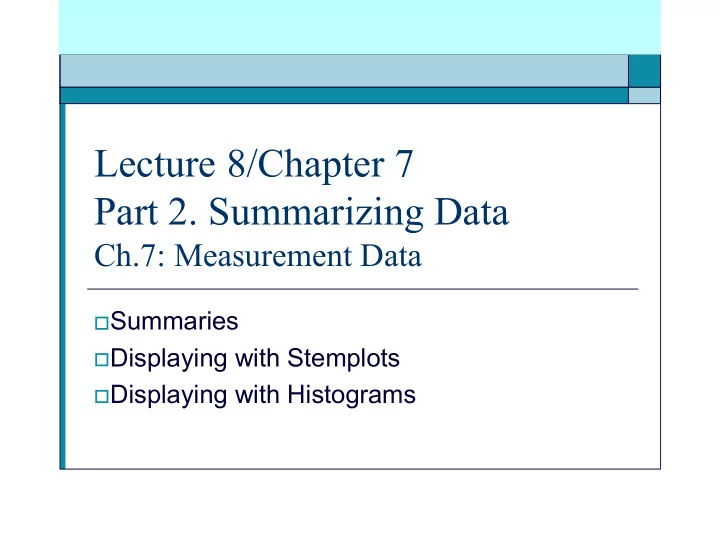

Lecture 8/Chapter 7 Part 2. Summarizing Data Ch.7: Measurement Data Summaries Displaying with Stemplots Displaying with Histograms
Course Divided into Four Parts (Review) Finding Data in Life (completed): 1. scrutinizing origin of data Finding Life in Data: summarizing data 2. yourself or assessing another’s summary Understanding Uncertainty in Life: 3. probability theory Making Judgments from Surveys and 4. Experiments: statistical inference
Definitions (Review) Variable : a characteristic that varies from one individual to another Statistics: the science of principles and procedures for gaining and processing data (info about variables’ values for a sample) and using the info to draw general conclusions Statistics: summaries of data (such as a sample average or sample proportion)
Definitions Summarize values of a quantitative (measurement) variable by telling center, spread, shape. Center : measure of what is typical in the distribution of a quantitative variable Spread: measure of how much the distribution’s values vary Shape: tells which values tend to be more or less common
Definitions Measures of Center sum of values mean= average= number of values median: the middle for odd number of values average of middle two for even number of values mode: most common value Measures of Spread Range: difference between highest & lowest Standard deviation (discussed later)
Example: Basic Summaries Background : Cigarettes smoked in a day for 22 smoking students: 1 2 4 5 7 10 10 10 10 12 15 15 15 20 20 20 20 20 20 20 25 30 Question: How can we summarize the data? Response: 1. center mean (average) = median = middle: mode (most common) =
Example: Basic Summaries Background : Cigarettes smoked in a day for 22 smoking students: 1 2 4 5 7 10 10 10 10 12 15 15 15 20 20 20 20 20 20 20 25 30 Question: How can we summarize the data? Response: 2. spread (variability): range is 3. shape:
Definitions for Shape Symmetric distribution : balanced on either side of center Skewed distribution: unbalanced (lopsided) Skewed left: has a few relatively low values Skewed right: has a few relatively high values Outliers: values noticeably far from the rest Unimodal: single-peaked Normal: a particular symmetric bell-shape
Displays of a Quantitative Variable Displays help us see the shape of the distribution. Stemplot Advantage: most detail Disadvantage: impractical for large data sets Histogram Advantage: works well for any size data set Disadvantage: some detail lost Boxplot Advantage: shows outliers, makes comparisons Disadvantage: much detail lost
Definition Stemplot: vertical list of stems, each followed by horizontal list of one-digit leaves 1-digit leaves stems . . . Split stems: If plot has too few stems, split into 2 (1st stem gets leaves 0-4, 2nd gets 5-9) or 5 (1st stem gets leaves 0-1, etc.) or 10.
Example: Basic Stemplot Background : Cigarettes smoked in a day for 22 smoking students: 1 2 4 5 7 10 10 10 10 12 15 15 15 20 20 20 20 20 20 20 25 30 Question: Construct stemplot, describe shape? Response:
Example: Splitting Stems Background : Earnings of 29 male students: 0 2 2 3 3 3 3 4 4 5 5 5 5 5 5 6 6 6 6 7 8 8 10 10 12 15 20 25 42 Question: Construct stemplot, describe shape? Response: start with 0 to 4 as stems: Almost all the values would appear in 0 2 2 etc. 0 the first line, resulting in a poor display. 1 2 3 4
Example: Splitting Stems 0 2 2 3 3 3 3 4 4 5 5 5 5 5 5 6 6 6 6 7 8 8 10 10 12 15 20 25 42 Response: split stems in 2: 0 0 1 1 Note: mean=___median=___th value=___range__ to__. 2 2 Shape is___________________ (picture it rotated to horizontal orientation with 0 at left, 4 at right); 3 Outliers? 3 4
Definition Histogram: to display quantitative values… Divide range of data into intervals of equal 1. width. Find count or percent or proportion in each. 2. Use horizontal axis for range of data values, 3. vertical axis for count/percent/proportion in each.
Example: Histogram Background : Earnings of 29 male students: 0 2 2 3 3 3 3 4 4 5 5 5 5 5 5 6 6 6 6 7 8 8 10 10 12 15 20 25 42 Question: Make histogram with midpoints 0, 5, etc? Response: Note: same shape as seen in stemplot.
Example: Another Histogram Background : Earnings of 47 female students: 0 1 1 2 2 2 2 2 2 2 2 2 2 2 3 3 3 3 3 3 3 3 3 3 3 4 4 4 4 4 5 5 5 5 7 7 8 8 8 10 12 15 17 18 25 26 34 Question: Make histogram with cutpoints 0, 5, etc? Response: (Note that stemplot would be tedious.) Center: mean=____ median=____th value=___ Spread: values range from ___ to ___ Shape: Similar to males’ shape?
Recommend
More recommend